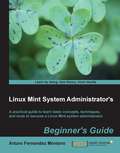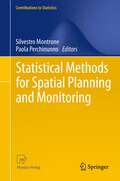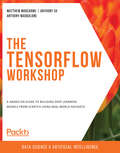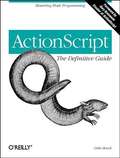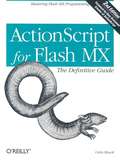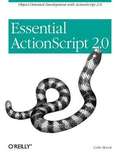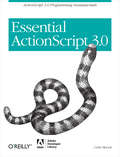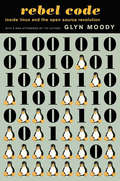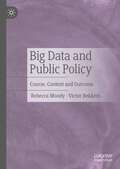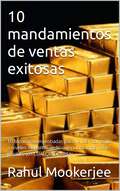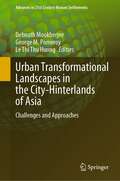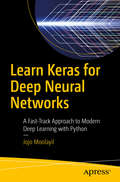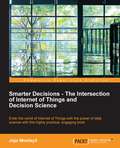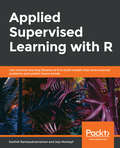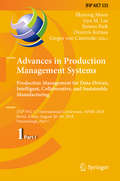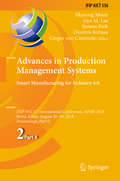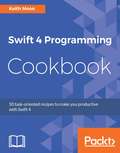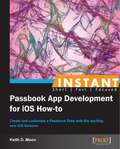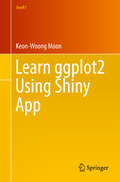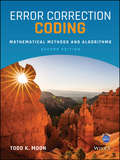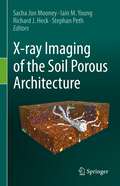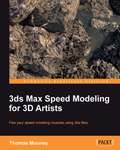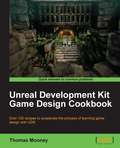- Table View
- List View
Linux Mint System Administrator’s Beginner's Guide
by Arturo Fernandez MontoroA concise Packt Beginner's Guide to get you started with administering a Linux Mint system. This book is for those users who want to become Linux Mint system administrators and need to start learning quickly. It's assumed that you have a basic knowledge of GNU/Linux operating systems, as well as being familiar with concepts, such as kernel, filesystems, users, accounts, groups, and disk partitions
Statistical Methods for Spatial Planning and Monitoring
by Silvestro Montrone Paola PerchinunnoThe book aims to investigate methods and techniques for spatial statistical analysis suitable to model spatial information in support of decision systems. Over the last few years there has been a considerable interest in these tools and in the role they can play in spatial planning and environmental modelling. One of the earliest and most famous definition of spatial planning was "a geographical expression to the economic, social, cultural and ecological policies of society": borrowing from this point of view, this text shows how an interdisciplinary approach is an effective way to an harmonious integration of national policies with regional and local analysis. A wide range of spatial models and techniques is, also, covered: spatial data mining, point processes analysis, nearest neighbor statistics and cluster detection, Fuzzy Regression model and local indicators of spatial association; all of these tools provide the policy-maker with a valuable support to policy development.
The TensorFlow Workshop: A hands-on guide to building deep learning models from scratch using real-world datasets
by Matthew Moocarme Anthony So Anthony MaddaloneGet started with TensorFlow fundamentals to build and train deep learning models with real-world data, practical exercises, and challenging activitiesKey FeaturesUnderstand the fundamentals of tensors, neural networks, and deep learningDiscover how to implement and fine-tune deep learning models for real-world datasetsBuild your experience and confidence with hands-on exercises and activitiesBook DescriptionGetting to grips with tensors, deep learning, and neural networks can be intimidating and confusing for anyone, no matter their experience level. The breadth of information out there, often written at a very high level and aimed at advanced practitioners, can make getting started even more challenging.If this sounds familiar to you, The TensorFlow Workshop is here to help. Combining clear explanations, realistic examples, and plenty of hands-on practice, it'll quickly get you up and running. You'll start off with the basics – learning how to load data into TensorFlow, perform tensor operations, and utilize common optimizers and activation functions. As you progress, you'll experiment with different TensorFlow development tools, including TensorBoard, TensorFlow Hub, and Google Colab, before moving on to solve regression and classification problems with sequential models. Building on this solid foundation, you'll learn how to tune models and work with different types of neural network, getting hands-on with real-world deep learning applications such as text encoding, temperature forecasting, image augmentation, and audio processing.By the end of this deep learning book, you'll have the skills, knowledge, and confidence to tackle your own ambitious deep learning projects with TensorFlow.What you will learnGet to grips with TensorFlow's mathematical operationsPre-process a wide variety of tabular, sequential, and image dataUnderstand the purpose and usage of different deep learning layersPerform hyperparameter-tuning to prevent overfitting of training dataUse pre-trained models to speed up the development of learning modelsGenerate new data based on existing patterns using generative modelsWho this book is forThis TensorFlow book is for anyone who wants to develop their understanding of deep learning and get started building neural networks with TensorFlow. Basic knowledge of Python programming and its libraries, as well as a general understanding of the fundamentals of data science and machine learning, will help you grasp the topics covered in this book more easily.
ActionScript: The Definitive Guide
by Colin MoockGiven its ability to deliver high-impact experiences even over low-bandwidth connections, Flash has become the de facto standard for hundreds of thousands of multimedia web developers worldwide. Flash 5 now includes a new full-fledged programming language called "ActionScript" for controlling animation and multimedia. It's a quantum leap from the bare-bones "Actions" supported in Flash 4, and ActionScript: The Definitive Guide is the first book dedicated entirely to documenting and demonstrating this new language. ActionScript includes all fundamental programming constructs (variables, loops, conditionals, functions, etc.), and is inextricably fused with Flash's authoring behaviors and animation timelines. Because ActionScript is based heavily on the ECMAScript Language Specification (ECMA-262) and is syntactically nearly identical to JavaScript, Macromedia expects thousands of existing JavaScript programmers to migrate to ActionScript. This book is divided into three sections. "ActionScript Fundamentals" introduces both programmers and non-programmers to the new language by first describing fundamental programming concepts and then delineating in detail the components, syntax, and usage of ActionScript. "Applied ActionScript Code Depot" shows you how to use common applications, such as processing online forms. "Language Reference" is a concise and detailed reference that makes all ActionScript globals, properties, and objects, including extensive implementation samples, easy to find quickly. Step-by-step tutorials of the most common ActionScript behaviors Object-oriented programming in Flash Intelligent interface development Server communication Dynamic content generation Password protection String handling Message boards Basic physics Games Code samples are also available from the "Code Depot" on the author's web site devoted to Flash developers. Topics covered in this book include: ActionScript: The Definitive Guide is structured so both programmers and non-programmers can learn how to use ActionScript. This book will take you well beyond simple Flash animations so you can create your own enhanced Flash-driven sites.
ActionScript for Flash MX: The Definitive Guide, 2nd Edition
by Colin MoockActionScript for Flash MX: The Definitive Guide is the most complete, up-to-date reference available for the latest version of ActionScript. Author Colin Moock has added hundreds of new code examples to show new Flash MX techniques in the real world. The book's language reference alone has nearly doubled from the first edition, with more than 250 new classes, objects, methods, and properties. You'll find exhaustive coverage of dozens of undocumented, under-documented, and mis-documented features.
ActionScript for Flash MX: The Definitive Guide, 2nd Edition
by Colin MoockUpdated to cover Flash MX, the newest version of Macromedia Flash, ActionScript for Flash MX: The Definitive Guide , Second Edition is the one book no serious Flash developer should be without. ActionScript is Macromedia's programming language for Flash MX, the popular authoring tool for creating rich internet applications and animations for the Web. With Macromedia's new focus on application development, ActionScript now includes a direct drawing API, loading of external MP3 and JPG files, improved sound control, an extensive set of text formatting tools, complete support for component development using movie clip subclasses, local data storage, accessibility features, and much more. And ActionScript for Flash MX: The Definitive Guide is the most complete, up-to-date reference available for the latest version of this language. Author Colin Moock, one of the most universally respected developers in the Flash community, has added hundreds of new code examples to show new Flash MX techniques in the real world: how to draw circles, save data to disk, convert arrays to onscreen tables, create reusable components, and preload variables, XML, and sounds. The book's language reference alone has nearly doubled from the first edition, with more than 250 new classes, objects, methods, and properties. You'll find exhaustive coverage of dozens of undocumented, under-documented, and mis-documented features. Along with the new material, Colin Moock has meticulously revised the entire text to conform to Flash MX best-coding practices. In particular, objected-oriented programming and the new event model get special attention in light of changes to Flash MX ActionScript. From sending data between two movies to creating getter/setter properties, the new edition of this book demystifies the often-confusing new features of Flash MX, giving developers easy access to its powerful new capabilities. ActionScript for Flash MX: The Definitive Guide is structured so non-programmers can learn how to use ActionScript and programmers can take their skills to new heights. If you are in the market to really learn about the hows and whys of ActionScript, then this is the book for you.
Essential ActionScript 2.0
by Colin MoockIn Essential ActionScript 2.0 , bestselling author Colin Moock covers everything you'll need to know about the new ActionScript language and its methodologies. Experienced Flash developers and programmers coming from other languages will enjoy the sheer depth of Moocks's coverage. Novice programmers will appreciate the frequent, low-jargon explanations that are often glossed over by advanced programming books. Essential ActionScript 2.0 is the one book every ActionScript coder must own.
Essential ActionScript 3.0
by Colin MoockActionScript 3.0 is a huge upgrade to Flash's programming language. The enhancements to ActionScript's performance, feature set, ease of use, cleanliness, and sophistication are considerable. Essential ActionScript 3.0 focuses on the core language and object-oriented programming, along with the Flash Player API. Essential ActionScript has become the #1 resource for the Flash and ActionScript development community, and the reason is the author, Colin Moock. Many people even refer to it simply as "The Colin Moock book." And for good reason: No one is better at turning ActionScript inside out, learning its nuances and capabilities, and then explaining everything in such an accessible way. Colin Moock is not just a talented programmer and technologist; he's also a gifted teacher. Essential ActionScript 3.0 is a radically overhauled update to Essential ActionScript 2.0. True to its roots, the book once again focuses on the core language and object-oriented programming, but also adds a deep look at the centerpiece of Flash Player's new API: display programming. Enjoy hundreds of brand new pages covering exciting new language features, such as the DOM-based event architecture, E4X, and namespaces--all brimming with real-world sample code. The ActionScript 3.0 revolution is here, and Essential ActionScript 3.0's steady hand is waiting to guide you through it. Adobe Developer Library is a co-publishing partnership between O'Reilly Media and Adobe Systems, Inc. and is designed to produce the number one information resources for developers who use Adobe technologies. Created in 2006, the Adobe Developer Library is the official source for comprehensive learning solutions to help developers create expressive and interactive web applications that can reach virtually anyone on any platform. With top-notch books and innovative online resources covering the latest in rich Internet application development, the Adobe Developer Library offers expert training and in-depth resources, straight from the source.
Rebel Code: Linux and the Open Source Revolution
by Glyn MoodyThe open source saga has many fascinating chapters. It is partly the story of Linus Torvalds, the master hacker who would become chief architect of the Linux operating system. It is also the story of thousands of devoted programmers around the world who spontaneously worked in tandem to complete the race to shape Linux into the ultimate killer app. Rebel Code traces the remarkable roots of this unplanned revolution. It echoes the twists and turns of Linux's improbable development, as it grew through an almost biological process of accretion and finally took its place at the heart of a jigsaw puzzle that would become the centerpiece of open source. With unprecedented access to the principal players, Moody has written a powerful tale of individual innovation versus big business. Rebel Code provides a from-the-trenches perspective and looks ahead to how open source is challenging long-held conceptions of technology, commerce, and culture.
Big Data and Public Policy: Course, Content and Outcome
by Rebecca Moody Victor BekkersThis book provides a comprehensive overview of how the course, content and outcome of policy making is affected by big data. It scrutinises the notion that big and open data makes policymaking a more rational process, in which policy makers are able to predict, assess and evaluate societal problems. It also examines how policy makers deal with big data, the problems and limitations they face, and how big data shapes policymaking on the ground. The book considers big data from various perspectives, not just the political, but also the technological, legal, institutional and ethical dimensions. The potential of big data use in the public sector is also assessed, as well as the risks and dangers this might pose. Through several extended case studies, it demonstrates the dynamics of big data and public policy. Offering a holistic approach to the study of big data, this book will appeal to students and scholars of public policy, public administration and data science, as well as those interested in governance and politics.
10 mandamientos de ventas exitosas
by Rahul MookerjeeEn el invierno de 2007, me uní a una pequeña empresa nueva como gerente de ventas y "persona sénior". La compañía era una startup de rango. Tenían literalmente tres personas trabajando allí, incluyéndome a mí, y los otros dos eran los gerentes de recursos humanos y operaciones. La empresa matriz es una empresa de BPO bastante exitosa y ha estado en el negocio durante aproximadamente 8 años. Estaban buscando expandirse al desarrollo web y no tenían ni idea de cómo conseguir clientes, a pesar de... …tener un gerente de ventas MUY exitoso al mando en términos de operaciones de BPO. Ha estado allí desde el inicio de la empresa y probablemente todavía ESTÁ trabajando allí.
Urban Transformational Landscapes in the City-Hinterlands of Asia: Challenges and Approaches (Advances in 21st Century Human Settlements)
by Debnath Mookherjee George M. Pomeroy Le Thi Thu HuongIn the context of mounting challenges stemming from a rapid transformation of the urban-regional landscapes in many Asian countries, this book highlights a multifaceted array of issues that increasingly engage the academic and planning communities in search of viable solutions to complex problems facing us. Even though cities continue to dominate development studies, urbanization of Asia is evolving toward a hybrid urban-rural nexus beyond the cities. This volume considers these shifting dynamics of Asian urbanization, including urban spatial transformations and their ramifications in the context of sustainability and planning. Through the lens of a set of empirical studies across diverse disciplines, geographies and methodologies. yet with an overarching concern for sustainability in varied (but interconnected) areas such as climate change, land use planning, infrastructure and urban mobility, and quality of life, these studies examine a range of important topics (e.g., flooding, transportation, housing, open space/ green space, urban garden and such) in city/regional settings. Together, they add insights into varied transformational processes or patterns at work on the urban-regional landscapes in a number of Asian countries while offering innovative approaches or alternatives. The proposed volume fills a gap in urban/regional studies in context of South and Southeast Asia that will be of interest to all stakeholders (e.g., planners, administrators, academicians and the citizenry), particularly those interested in sustainability and planning paradigms. It should be a timely and valuable addition to the Asian urbanization literature.
Learn Keras for Deep Neural Networks: A Fast-track Approach To Modern Deep Learning With Python
by Jojo MoolayilLearn, understand, and implement deep neural networks in a math- and programming-friendly approach using Keras and Python. The book focuses on an end-to-end approach to developing supervised learning algorithms in regression and classification with practical business-centric use-cases implemented in Keras. The overall book comprises three sections with two chapters in each section. The first section prepares you with all the necessary basics to get started in deep learning. Chapter 1 introduces you to the world of deep learning and its difference from machine learning, the choices of frameworks for deep learning, and the Keras ecosystem. You will cover a real-life business problem that can be solved by supervised learning algorithms with deep neural networks. You’ll tackle one use case for regression and another for classification leveraging popular Kaggle datasets. Later, you will see an interesting and challenging part of deep learning: hyperparameter tuning; helping you further improve your models when building robust deep learning applications. Finally, you’ll further hone your skills in deep learning and cover areas of active development and research in deep learning. At the end of Learn Keras for Deep Neural Networks, you will have a thorough understanding of deep learning principles and have practical hands-on experience in developing enterprise-grade deep learning solutions in Keras. What You’ll Learn Master fast-paced practical deep learning concepts with math- and programming-friendly abstractions. Design, develop, train, validate, and deploy deep neural networks using the Keras framework Use best practices for debugging and validating deep learning models Deploy and integrate deep learning as a service into a larger software service or product Extend deep learning principles into other popular frameworks Who This Book Is For Software engineers and data engineers with basic programming skills in any language and who are keen on exploring deep learning for a career move or an enterprise project.
Smarter Decisions – The Intersection of Internet of Things and Decision Science
by Jojo MoolayilEnter the world of Internet of Things with the power of data science with this highly practical, engaging book About This Book * Explore real-world use cases from the Internet of Things (IoT) domain using decision science with this easy-to-follow, practical book * Learn to make smarter decisions on top of your IoT solutions so that your IoT is smart in a real sense * This highly practical, example-rich guide fills the gap between your knowledge of data science and IoT Who This Book Is For If you have a basic programming experience with R and want to solve business use cases in IoT using decision science then this book is for you. Even if your're a non-technical manager anchoring IoT projects, you can skip the code and still benefit from the book. What You Will Learn * Explore decision science with respect to IoT * Get to know the end to end analytics stack - Descriptive + Inquisitive + Predictive + Prescriptive * Solve problems in IoT connected assets and connected operations * Design and solve real-life IoT business use cases using cutting edge machine learning techniques * Synthesize and assimilate results to form the perfect story for a business * Master the art of problem solving when IoT meets decision science using a variety of statistical and machine learning techniques along with hands on tasks in R In Detail With an increasing number of devices getting connected to the Internet, massive amounts of data are being generated that can be used for analysis. This book helps you to understand Internet of Things in depth and decision science, and solve business use cases. With IoT, the frequency and impact of the problem is huge. Addressing a problem with such a huge impact requires a very structured approach. The entire journey of addressing the problem by defining it, designing the solution, and executing it using decision science is articulated in this book through engaging and easy-to-understand business use cases. You will get a detailed understanding of IoT, decision science, and the art of solving a business problem in IoT through decision science. By the end of this book, you'll have an understanding of the complex aspects of decision making in IoT and will be able to take that knowledge with you onto whatever project calls for it Style and approach This scenario-based tutorial approaches the topic systematically, allowing you to build upon what you learned in previous chapters.
Applied Supervised Learning with R: Use machine learning libraries of R to build models that solve business problems and predict future trends
by Jojo Moolayil Karthik RamasubramanianExplore supervised machine learning with R by studying popular real-world uses cases such as object detection in driverless cars, customer churn, and default predictionKey FeaturesStudy supervised learning algorithms by using real-world datasets Fine tune optimal parameters with hyperparameter optimizationSelect the best algorithm using the model evaluation frameworkBook DescriptionR provides excellent visualization features that are essential for exploring data before using it in automated learning. Applied Supervised Learning with R helps you cover the complete process of employing R to develop applications using supervised machine learning algorithms for your business needs. The book starts by helping you develop your analytical thinking to create a problem statement using business inputs and domain research. You will then learn different evaluation metrics that compare various algorithms, and later progress to using these metrics to select the best algorithm for your problem. After finalizing the algorithm you want to use, you will study the hyperparameter optimization technique to fine-tune your set of optimal parameters. To prevent you from overfitting your model, a dedicated section will even demonstrate how you can add various regularization terms.By the end of this book, you will have the advanced skills you need for modeling a supervised machine learning algorithm that precisely fulfills your business needs.What you will learnDevelop analytical thinking to precisely identify a business problemWrangle data with dplyr, tidyr, and reshape2Visualize data with ggplot2Validate your supervised machine learning model using k-fold Optimize hyperparameters with grid and random search, and Bayesian optimizationDeploy your model on Amazon Web Services (AWS) Lambda with plumberImprove your model’s performance with feature selection and dimensionality reductionWho this book is forThis book is specially designed for novice and intermediate-level data analysts, data scientists, and data engineers who want to explore different methods of supervised machine learning and its various use cases. Some background in statistics, probability, calculus, linear algebra, and programming will help you thoroughly understand and follow the content of this book.
Advances in Production Management Systems. Production Management for Data-Driven, Intelligent, Collaborative, and Sustainable Manufacturing: IFIP WG 5.7 International Conference, APMS 2018, Seoul, Korea, August 26-30, 2018, Proceedings, Part I (IFIP Advances in Information and Communication Technology #535)
by Ilkyeong Moon Gyu M. Lee Jinwoo Park Dimitris Kiritsis Gregor Von CieminskiThe two-volume set IFIP AICT 535 and 536 constitutes the refereed proceedings of the International IFIP WG 5.7 Conference on Advances in Production Management Systems, APMS 2018, held in Seoul, South Korea, in August 2018.The 129 revised full papers presented were carefully reviewed and selected from 149 submissions. They are organized in the following topical sections: lean and green manufacturing; operations management in engineer-to-order manufacturing; product-service systems, customer-driven innovation and value co-creation; collaborative networks; smart production for mass customization; global supply chain management; knowledge based production planning and control; knowledge based engineering; intelligent diagnostics and maintenance solutions for smart manufacturing; service engineering based on smart manufacturing capabilities; smart city interoperability and cross-platform implementation; manufacturing performance management in smart factories; industry 4.0 - digital twin; industry 4.0 - smart factory; and industry 4.0 - collaborative cyber-physical production and human systems.
Advances in Production Management Systems. Smart Manufacturing for Industry 4.0: IFIP WG 5.7 International Conference, APMS 2018, Seoul, Korea, August 26-30, 2018, Proceedings, Part II (IFIP Advances in Information and Communication Technology #536)
by Ilkyeong Moon Gyu M. Lee Jinwoo Park Dimitris Kiritsis Gregor Von CieminskiThe two-volume set IFIP AICT 535 and 536 constitutes the refereed proceedings of the International IFIP WG 5.7 Conference on Advances in Production Management Systems, APMS 2018, held in Seoul, South Korea, in August 2018.The 129 revised full papers presented were carefully reviewed and selected from 149 submissions. They are organized in the following topical sections: lean and green manufacturing; operations management in engineer-to-order manufacturing; product-service systems, customer-driven innovation and value co-creation; collaborative networks; smart production for mass customization; global supply chain management; knowledge based production planning and control; knowledge based engineering; intelligent diagnostics and maintenance solutions for smart manufacturing; service engineering based on smart manufacturing capabilities; smart city interoperability and cross-platform implementation; manufacturing performance management in smart factories; industry 4.0 - digital twin; industry 4.0 - smart factory; and industry 4.0 - collaborative cyber-physical production and human systems.
Swift 4 Programming Cookbook
by Keith MoonOver 50 recipes to help you quickly and efficiently build applications with Swift 4 and Xcode 9 About This Book • Write robust and efficient code and avoid common pitfalls using Swift 4 • Get a comprehensive coverage of the tools and techniques needed to create multi-platform apps with Swift 4 • Packed with easy-to-follow recipes, this book will help you develop code using the latest version of Swift Who This Book Is For If you are looking for a book to help you learn about the diverse features offered by Swift 4 along with tips and tricks to efficiently code and build applications, then this book is for you. Basic knowledge of Swift or general programming concepts will be beneficial. What You Will Learn • Explore basic to advanced concepts in Swift 4 Programming • Unleash advanced features of Apple's Xcode 9 IDE and Swift Playgrounds • Learn about the conditional statements, loops, and how to handle errors in Swift • Define flexible classes and structs using Generics, and learn about the advanced operators, and create custom operators • Explore functionalities outside of the standard libraries of Swift • Import your own custom functionality into Swift Playgrounds • Run Swift on Linux and investigate server-side programming with the server side framework Vapor In Detail Swift 4 is an exciting, multi-platform, general-purpose programming language. Being open source, modern and easy to use has made Swift one of the fastest growing programming languages. If you interested in exploring it, then this book is what you need. The book begins with an introduction to the basic building blocks of Swift 4, its syntax and the functionalities of Swift constructs. Then, introduces you to Apple's Xcode 9 IDE and Swift Playgrounds, which provide an ideal platform to write, execute, and debug the codes thus initiating your development process. Next, you'll learn to bundle variables into tuples, set order to your data with an array, store key-value pairs with dictionaries and you'll learn how to use the property observers. Later, explore the decision-making and control structures in Swift and learn how to handle errors in Swift 4. Then you'll, examine the advanced features of Swift, generics and operators, and then explore the functionalities outside of the standard library, provided by frameworks such as Foundation and UIKit. Also, you'll explore advanced features of Swift Playgrounds. At the end of the book, you'll learn server-side programming aspect of Swift 4 and see how to run Swift on Linux and then investigate Vapor, one of the most popular server-side frameworks for Swift. Style and approach Each recipe addresses a specific problem, with a detailed discussion that explains the solution and offers insight into how it works.
Instant Passbook App Development for iOS How-to
by Keith D. MoonFilled with practical, step-by-step instructions and clear explanations for the most important and useful tasks. A step-by-step guide, focusing on simple projects to help you create a Passbook app for iOS 6.Instant Passbook App Development for iOS 6 How-to is for registered Apple iOS developers, experienced in building an app using Objective-C and Xcode, looking to add Passbook functionality to their app. You will need to have an understanding of the JSON format, REST APIs, and a server-side language like Ruby. Familiarity with executing commands via the Terminal app is expected for the exercises within this book.
Learn ggplot2 Using Shiny App
by Keon-Woong MoonThis book and app is for practitioners, professionals, researchers, and students who want to learn how to make a plot within the R environment using ggplot2, step-by-step without coding. In widespread use in the statistical communities, R is a free software language and environment for statistical programming and graphics. Many users find R to have a steep learning curve but to be extremely useful once overcome. ggplot2 is an extremely popular package tailored for producing graphics within R but which requires coding and has a steep learning curve itself, and Shiny is an open source R package that provides a web framework for building web applications using R without requiring HTML, CSS, or JavaScript. This manual--"integrating" R, ggplot2, and Shiny--introduces a new Shiny app, Learn ggplot2, that allows users to make plots easily without coding. With the Learn ggplot2 Shiny app, users can make plots using ggplot2 without having to code each step, reducing typos and error messages and allowing users to become familiar with ggplot2 code. The app makes it easy to apply themes, make multiplots (combining several plots into one plot), and download plots as PNG, PDF, or PowerPoint files with editable vector graphics. Users can also make plots on any computer or smart phone. Learn ggplot2 Using Shiny App allows users to Make publication-ready plots in minutes without coding Download plots with desired width, height, and resolution Plot and download plots in png, pdf, and PowerPoint formats, with or without R code and with editable vector graphics
Windows® 7 Plain & Simple
by Marianne Moon Jerry JoyceGet the fast facts that make learning Windows 7 plain and simple! This no-nonsense guide uses easy, numbered steps and concise, straightforward language to show the most expedient way to perform tasks and solve problems in Windows 7. Here's what you'll learn to do: Run programs, control gadgets, play games. Send e-mail, browse the Web, and share your files. Organize your digital media, including photos, music, and videos. Burn CDs and DVDs; make your own movies. Set up your printer and a simple home network. Manage security settings and perform easy tune-ups and fixes. Here's how you'll learn it: Jump in wherever you need answers. Easy-to-follow steps and screenshots show you exactly what to do. Handy tips teach you new techniques and shortcuts. Quick TRY THIS! exercises help you apply what you've learned right away. offer the CD/DVD content as a free download via OReilly Medias Digital Distribution services. To download this content, please visit OReillys web site, search for the title of this book to find its catalog page, and click on the link below the cover image (Examples, Companion Content, or Practice Files). Note that while we provide as much of the media content as we are able via free download, we are sometimes limited by licensing restrictions. Please direct any questions or concerns to booktech@oreilly.com.
Error Correction Coding: Mathematical Methods and Algorithms
by Todd K. MoonProviding in-depth treatment of error correction Error Correction Coding: Mathematical Methods and Algorithms, 2nd Edition provides a comprehensive introduction to classical and modern methods of error correction. The presentation provides a clear, practical introduction to using a lab-oriented approach. Readers are encouraged to implement the encoding and decoding algorithms with explicit algorithm statements and the mathematics used in error correction, balanced with an algorithmic development on how to actually do the encoding and decoding. Both block and stream (convolutional) codes are discussed, and the mathematics required to understand them are introduced on a “just-in-time” basis as the reader progresses through the book. The second edition increases the impact and reach of the book, updating it to discuss recent important technological advances. New material includes: Extensive coverage of LDPC codes, including a variety of decoding algorithms. A comprehensive introduction to polar codes, including systematic encoding/decoding and list decoding. An introduction to fountain codes. Modern applications to systems such as HDTV, DVBT2, and cell phones Error Correction Coding includes extensive program files (for example, C++ code for all LDPC decoders and polar code decoders), laboratory materials for students to implement algorithms, and an updated solutions manual, all of which are perfect to help the reader understand and retain the content. The book covers classical BCH, Reed Solomon, Golay, Reed Muller, Hamming, and convolutional codes which are still component codes in virtually every modern communication system. There are also fulsome discussions of recently developed polar codes and fountain codes that serve to educate the reader on the newest developments in error correction.
X-ray Imaging of the Soil Porous Architecture
by Sacha Jon Mooney Iain M. Young Richard J. Heck Stephan PethThe advent of X-ray Computed Tomography (CT) as a tool for the soil sciences almost 40 years ago has revolutionised the field. Soil is the fragile, thin layer of material that exists above earth’s geological substrates upon which so much of life on earth depends. However a major limitation to our understanding of how soils behave and function is due to its complex, opaque structure that hinders our ability to assess its porous architecture without disturbance. X-ray imagery has facilitated the ability to truly observe soil as it exists in three dimensions and across contrasting spatial and temporal scales in the field in an undisturbed fashion. This book gives a comprehensive overview of the “state of the art” in a variety of application areas where this type of imaging is used, including soil water physics and hydrology, agronomic management of soils, and soil-plant-microbe interactions. It provides the necessary details for entry level readers in the crucial areas of sample preparation, scanner optimisation and image processing and analysis. Drawing on experts across the globe, from both academia and industry, the book covers the necessary “dos and don’ts”, but also offers insights into the future of both technology and science. The wider application of the book is provided by dedicated chapters on how the data from such imagery can be incorporated into models and how the technology can be interfaced with other relevant technical applications. The book ends with a future outlook from the four editors, each of whom has over 20 years of experience in the application of X-ray CT to soil science.
3ds Max Speed Modeling for Games
by Thomas MooneyStep by step illustrated tutorials are supported by a focused commentary. The examples are designed to proceed from starting to model through model finishing to putting models to work within projects and presentation. The book shows both - the entire flow of asset creation and granular methodology. This book will appeal to anyone interested in 3D modeling who wants to improve their speed modeling ability, particularly artists whose work is relevant to industries where hard surface modeling or model prototyping is required, such as games, films, or visualization.
Unreal Development Kit Game Design Cookbook
by Thomas MooneyWritten in cookbook style, this book offers many recipes to learn game design with UDK. Each recipe contains step-by-step instructions followed by analysis of what was done in each task and other useful information. The book is designed so that you can read it chapter by chapter, or you can look at the list of recipes and refer to them in no particular order. This book is meant for game artists who are getting used to UDK but may feel the need for guidance on matters of implementation. It also targets brave beginners who are struggling to find an all in one package for getting started with UDK, and want a ready to hand reference. Level designers can use this book to gauge their understanding of the editor, check for specific problems, and discover gems they may not have come across before.
